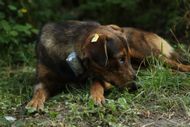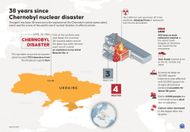A population of dogs thrives in the radioactive environment of Chernobyl. This nuclear disaster on April 26, 1986, was one of the most terrible events in human history. While the human population was evacuated and left behind their pets, scientific studies have begun to unravel how these canines have adapted to such a hostile habitat. According to the head researcher, Dr. Norman J. Kleiman:
“Somehow, two small populations of dogs managed to survive in that highly toxic environment.”
Researchers estimate that approximately 500 feral dogs remain in the Chernobyl Exclusion Zone. These have been divided into distinct packs, scavenging for food around abandoned buildings and accepting scraps from visitors and workers.
Curiously enough, two populations have been formed: one around the Chernobyl Nuclear Power Plant and another about 10 miles away in Chernobyl City. The genetic studies proved that the two aforementioned populations are genetically distinct and rarely interbreed. The study was published in the journal Canine Medicine and Genetics.
How did Chernobyl dogs survive?

Research led by the scientist Dr. Norman J. Kleiman provided insight into dogs' genetic adaptations. Results of the analysis of blood from more than 300 dogs sampled showed genetic differences between these dogs living near the power plant and those in Chernobyl City. Dr. Matthew Breen from NC State was quoted by earth.com stating:
“The overarching question here is: does an environmental disaster of this magnitude have a genetic impact on life in the region?”
The study found 391 genomic regions that differed between the two groups, some seemingly reflecting possible genetic mechanisms for repair from radiation. Dr. Breen added:
“Think of these regions as markers, or signposts, on a highway. They identify areas within the genome where we should look more closely at nearby genes”.
These findings suggest that such dogs are probably undergoing rapid evolution with environmental variables. They possess characteristics that would enable them to live in the most extreme conditions of winter with limited food availability. Their genetic structure has been characterized as distinct from other pure-bred dogs and free-breeding canines globally.
This has raised several concerns about health issues with the dogs of Chernobyl, with scientists noting evidence of increased rates of cataracts and other problems common among atomic bomb survivors from the Second World War.
Due to these findings, several organizations have now come forward to take care of the dogs of Chernobyl. Vaccination programs, medical care, and adoption are some of the initiatives being taken to improve their lives and provide options other than the exclusion zone.
The scientists underline that all that is just the beginning of the research of long-term radiation exposure for animal genomes. Further research will be required to pinpoint specific genetic mutations associated with survival under such conditions. Dr. Breen further added:
“At this stage, we cannot say for sure that any genetic alterations are in response to the multigenerational and complex exposures; we have a lot more work to do to determine if that is the case.”
He continued -
“The question we must answer now is why are there striking genetic differences between the two dog populations? Are the differences just due to genetic drift, or are they due to the unique environmental stressors at each location?”
Historical context
The city of Pripyat and immediate environs were evacuated after the accident. Many pets, including dogs, were left behind. It is presumed that these dogs are the descendants of those left during the chaotic evacuation. Though Soviet soldiers attempted to cull stray animals to prevent the spread of radiation, some dogs evaded capture and were fed by cleanup crews and workers who remained in the area.
What happened at Chernobyl?

The Chernobyl disaster is the largest in the entire domain of nuclear power. It happened in one of the USSR’s atomic energy plants on April 26, 1986. This disastrous situation occurred when design errors in the reactor coupled with human mistakes in the course of a safety exercise.
On the night of April 25, one of the technicians at the reactor Unit 4 began a simulation of an outside power failure. This involved, in particular, the deactivation of some of the safety devices and the withdrawal of most control rods from the reactor core, which led to an uncontrolled sequence of nuclear fission. At 1:4 AM on April 26, a power spike was recorded, which led to explosions that opened up the reactor and dispersed the radioactive materials.
These blasts ruptured the core of the reactor, ignited fires to swirl around across the countryside, and radioactive materials flew far and wide. Indeed, a good amount of the reactor core was released into the environment, perhaps one of the most serious uncontrolled releases of radioactive material in history.
The explosions instantly killed two workers at the plant, and 28 emergency responders died of acute radiation syndrome within weeks. More than 100 others received radiation injuries. Radioactive isotopes were released over a wide area, contaminating millions of acres in Ukraine, Belarus, and elsewhere. United Nations report projected up to 9,000 potential cancer-related fatalities among those exposed.
